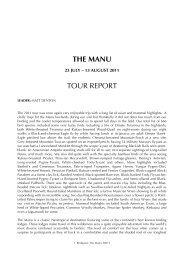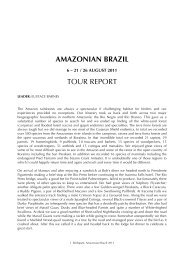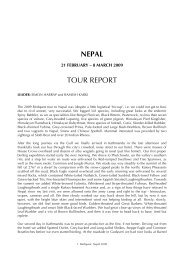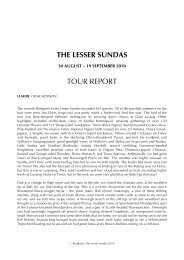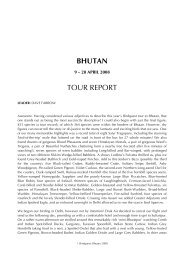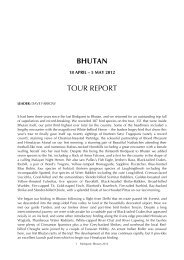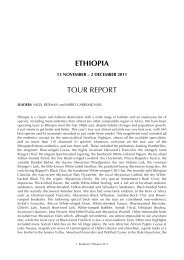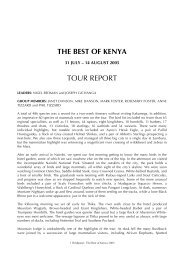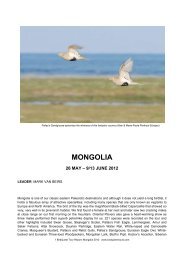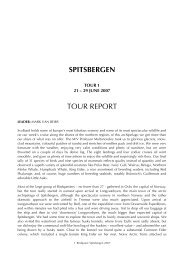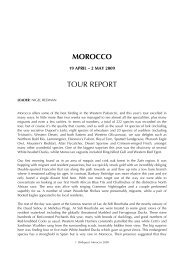THE CAPE VERDE ISLANDS TOUR REPORT - Birdquest
THE CAPE VERDE ISLANDS TOUR REPORT - Birdquest
THE CAPE VERDE ISLANDS TOUR REPORT - Birdquest
You also want an ePaper? Increase the reach of your titles
YUMPU automatically turns print PDFs into web optimized ePapers that Google loves.
Boyd’s Shearwaters as well but these were rather distant and the views were rather brief but as always<br />
the Cape Verde Shearwaters kept us entertained throughout our vigil. After lunch we were taken up to<br />
the Monte Gordo Natural Park offices where we met Tali who explained about the setting up and<br />
running of the park as well as the problems with the government granting permits for Raso and<br />
Branco. This was a problem that was affecting us as much as anyone else even though our agents<br />
were trying their hardest to get the relevant permission before our planned trip to the islands. On our<br />
drive back to Tarrafal we encountered the first Helmeted Guineafowl of the trip, Toy was the first to<br />
spot them as they scurried up a hillside and away from the road. In the evening we did another<br />
seawatch but the species were much the same as the other seawatches and then it was back to Casa<br />
Alice for another fine and substantial evening meal.<br />
The following day was the day of reckoning but when the phone call came through the news was<br />
what we had been building ourselves up for. Unfortunately the government did not grant us the<br />
permission to land on Raso or Branco and so we would only be allowed to stay on the boat but<br />
would get as close as we could in our efforts to see the endemic Raso Lark. The crossing to Raso was<br />
a fairly calm one, and bird wise it was fairly flat as well because apart from the customary Cape<br />
Verde Shearwaters, all we saw were three Fea’s Petrels until we got close to the island. Then the<br />
shearwaters were replaced by Brown Boobies and Red-tailed Tropicbirds coming and going from<br />
their cliff colonies. The tropicbirds were one of the highlights of the tour as they went through their<br />
aerobatic courtship flights over our boat. Although the seabirds were excellent we had to think about<br />
how we were going to get the lark, which wasn’t going to be easy. We took the boat down to the<br />
south western end of Raso which is one of the best areas to see this bird if you can land on the island.<br />
Fortunately for us the conditions were favourable and after only a short wait we could see one bird as<br />
it occasionally performed its song flight. The views weren’t brilliant, in fact they weren’t even good,<br />
but we were able to observe the species from the boat which was better than it could have been. Also<br />
whilst sitting off shore we saw a couple of Ospreys, a Little Egret, a Eurasian Whimbrel, some Ruddy<br />
Turnstones, a Brown-necked Raven and a few distant Iago Sparrows which was basically what we<br />
would have seen if we were actually on the island. All in all we did very well considering we didn’t<br />
have any landing permission but it did mean that we couldn’t spend any time on Branco and so mid<br />
afternoon we returned to Tarrafal. After dinner we went out hunting for Cape Verde Barn Owl in the<br />
area around Praia Branca but we didn’t have much luck and after a couple of hours we returned to<br />
Casa Alice empty handed.<br />
We then had another day on São Nicolau because of the internal flight schedule and so we headed<br />
out to Ponta Do Barril for another seawatch which produced much of what we had been seeing on<br />
our other visits. Later in the morning the weather looked good inland and so we went up to the<br />
Monte Gordo Natural Park. Although this was not very productive on the avian front the botanical<br />
treasures were memorable with species like the numerous Euphorbia tuckeyana, the purple flowered<br />
Campanula jacobaea, the succulent Aeonium gorgoneum, the rather delicate Língua-de-vaca Echium<br />
stenosiphon and the yellow flowered Nauplius smithii. All of these plants are endemic to the Cape<br />
Verde Islands but they all have closely related species in the Canary Islands. After a late lunch and a<br />
lazy afternoon we went back to Ponta Do Barril for one last seawatch but we couldn’t locate anything<br />
different no matter how hard we tried.<br />
Our last full day on São Nicolau started with a boat trip out from Tarrafal to a few kilometres off<br />
Ponta Do Barril then parallel to the coast before returning to Tarrafal about mid day. We took a good<br />
supply of fish with us and from soon after leaving port we had a group of Cape Verde Shearwaters in<br />
permanent attendance that gave us some spectacular close up views. For the majority of our trip this<br />
was the only species we saw but a brief purple patch late on produced a couple of close Fea’s Petrels<br />
and the only Boyd’s Shearwater. This was one of the main target species for the trip as a couple of our<br />
group had not got on to any of the birds seen from the Ponta Do Barril during our various<br />
seawatching sessions. Fortunately this bird came close to the boat and was seen well by everyone<br />
even though it was just a brief encounter. The afternoon was spent at leisure but late on we went up<br />
2 <strong>Birdquest</strong>: The Cape Verde Islands 2008




